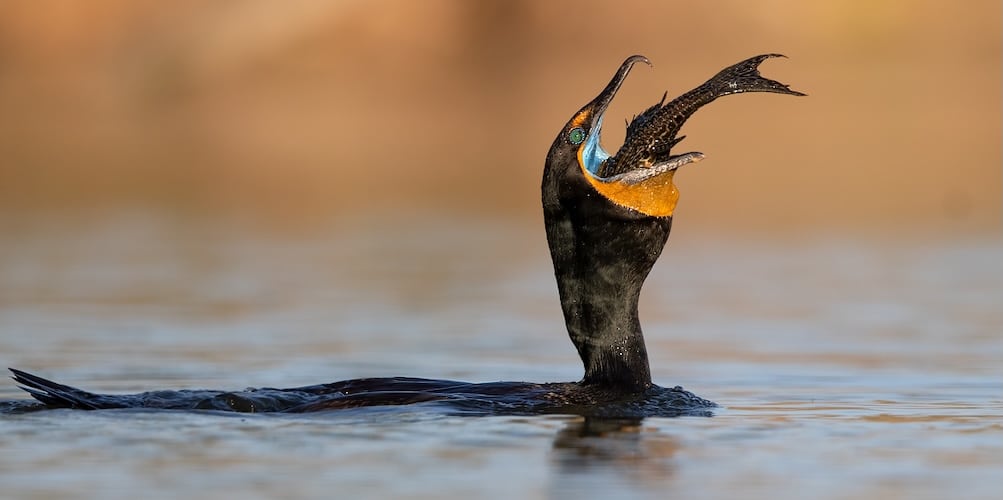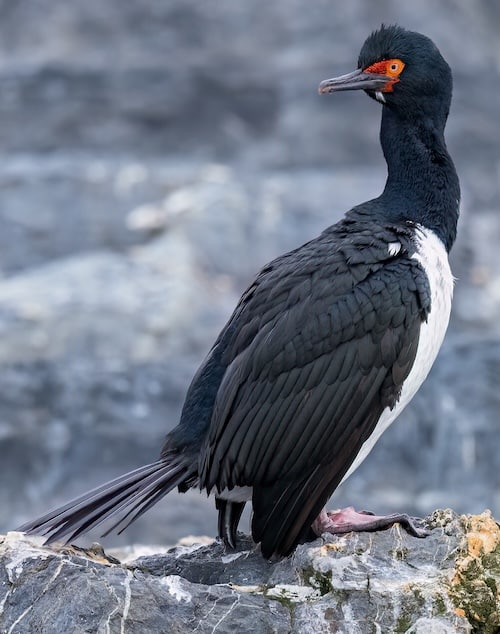Phalacrocoracidae – Cormorants & Shags

The Phalacrocoracidae is a family of about 34 species of aquatic birds commonly known as cormorants or shags. Along with Sulidae (Boobies & Gannets) and Anhingidae (Darters & Anhingas) they are part of the avian order of Suliformes. Several different classifications of the family have been proposed recently, and the number of genera is disputed. There is no consistent distinction between cormorants and shags as these appellations have been assigned to different species seemingly randomly.
They are medium-to-large seabirds. They range in size from the Pygmy Cormorant Phalacrocorax pygmaeus, at as little as 45cm and 340g, to the Flightless Cormorant Phalacrocorax harrisi, at a maximum size 100cm and 5kg. The recently extinct Spectacled Cormorant Phalacrocorax perspicillatus was rather larger, at an average size of 6.3kg.

Double-crested Cormorant Nannopterum auritus – ©Dubi Shapiro
The majority, including nearly all Northern Hemisphere species, have mainly dark plumage, but some Southern Hemisphere species are black and white, and a few (e.g. the Spotted Shag of New Zealand) are quite colourful. Many species have areas of coloured skin on the face (the lores and the gular skin) which can be bright blue, orange, red or yellow, typically becoming more brightly coloured in the breeding season. The bill is long, thin, and sharply hooked. Their feet have webbing between all four toes, as in their relatives.

Cape Cormorant Phalacrocorax capensis – ©Dubi Shapiro
They are coastal rather than oceanic birds, and some have colonised inland waters – indeed, the original ancestor of cormorants seems to have been a fresh-water bird, judging from the habitat of the most ancient lineage. They range around the world, except for the central Pacific islands.
All are fish-eaters, taking small eels, other fish, and even water snakes. They dive from the surface, though many species make a characteristic half-jump as they dive, presumably to give themselves a more streamlined entry into the water. Under water they propel themselves with their feet, though some also propel themselves with their wings. Some cormorant species have been found to dive to depths of as much as 45 metres.
After fishing, cormorants go ashore, and are frequently seen holding their wings out in the sun. All cormorants have preen gland secretions that are used ostensibly to keep the feathers waterproof. Some sources state that cormorants have waterproof feathers while others say that they have water permeable feathers. Still others suggests that the outer plumage absorbs water but does not permit it to penetrate the layer of air next to the skin. The wing drying action is seen even in the flightless cormorant but commonly in the Antarctic Shag and Red-legged Cormorant.

Rock Shag (Magellanic Cormorant) Leucocarbo magellanicus – ©Dubi Shapiro
Alternate functions suggested for the spread-wing posture include that it aids thermoregulation, digestion, balances the bird or indicates presence of fish. A detailed study of the great cormorant concludes that it is, without doubt, to dry the plumage.
Cormorants are colonial nesters, using trees, rocky islets, or cliffs. The eggs are a chalky-blue colour. There is usually one brood a year. The young are fed through regurgitation. They typically have deep, ungainly bills, showing a greater resemblance to those of the pelicans, to which they are related, than is obvious in the adults.
-
Number of bird species: 34
(As at August 2025)
According to the recently (2025) combined AviList, after recent DNA study, there are 34 extant species of Cormorants & Shags in seven genera of the family Phalacrocoracidae; they are:
Crowned Cormorant Microcarbo coronatus
Reed Cormorant Microcarbo africanus
Little Pied Cormorant Microcarbo melanoleucos
Pygmy Cormorant Microcarbo pygmeus
Little Cormorant Microcarbo niger
Red-legged Cormorant Poikilocarbo gaimardi
European Shag Gulosus aristotelis
Flightless Cormorant Nannopterum harrisi
Neotropic Cormorant Nannopterum brasilianum
Double-crested Cormorant Nannopterum auritus
Rock Shag Leucocarbo magellanicus
Guanay Cormorant Leucocarbo bougainvilliorum
Bounty Shag Leucocarbo ranfurlyi
New Zealand King Shag Leucocarbo carunculatus
Otago Shag Leucocarbo chalconotus
Chatham Shag Leucocarbo onslowi
Auckland Shag Leucocarbo colensoi
Campbell Shag Leucocarbo campbelli
Imperial Shag Leucocarbo atriceps
Brandt’s Cormorant Urile penicillatus
Red-faced Cormorant Urile urile
Pelagic Cormorant Urile pelagicus
Pallas’s Cormorant Urile perspicillatus
Bank Cormorant Phalacrocorax neglectus
Cape Cormorant Phalacrocorax capensis
Japanese Cormorant Phalacrocorax capillatus
Great Cormorant Phalacrocorax carbo
Socotra Cormorant Phalacrocorax nigrogularis
Pitt Shag Phalacrocorax featherstoni
Spotted Shag Phalacrocorax punctatus
Indian Cormorant Phalacrocorax fuscicollis
Little Black Cormorant Phalacrocorax sulcirostris
Black-faced Cormorant Phalacrocorax fuscescens
Australian Pied Cormorant Phalacrocorax varius
~~~~~
Taxon stewarti (below) is treated as a subspecies of Leucocarbo chalconotus based on the multilocus DNA analysis of Rawlence et al. (2022), supported by phenotypic data. Further analysis may show that L. onslowi should also be subsumed within L. chalconotus.
Foveaux Shag Leucocarbo (chalconotus) stewarti
Six taxa (below) often previously considered species are treated as subspecies of Leucocarbo atriceps based on multilocus DNA evidence (Rawlence et al. 2022). Despite being widely separated on subantarctic islands and their sedentary nature, taxa in the L. atriceps complex are only weakly diverged in plumage and in mitochondrial and nuclear DNA. An expanded L. atriceps is recognised pending further research on taxonomic limits within this complex.
South Georgia Shag Leucocarbo (atriceps) georgianus
Antarctic Shag Leucocarbo (atriceps) bransfieldensis
Heard Island Shag Leucocarbo (atriceps) nivalis
Crozet Shag Leucocarbo (atriceps) melanogenis
Macquarie Shag Leucocarbo (atriceps) purpurascens
Kerguelen Shag Leucocarbo (atriceps) verrucosus
White-breasted Cormorant Phalacrocorax (carbo) lucidus has also been ‘demoted’ to a sub-species of Great Cormorant.
-
Cormorants Research Group
WebsiteThe Wetlands International Cormorant Research Group was officially founded at the 3rd European Cormorant Conference held in Gdansk, Poland, in April 1993.
-
Flight Identification of European Seabirds
| By Anders Blomdahl, Bertil Breife & Niklas Holmstrom | Helm | 2007 | Paperback | 374 pages, 690 colour photos | ISBN: 9780713686166 Buy this book from NHBS.com -
Pelicans, Cormorants and their Relatives - The Pelicaniformes
| By J Bryan Nelson, illustrated by John Busby, Andrew Mackay & Bas Teunis | OUP | 2006 | Hardback | 661 pages, 12 colour plates, 159 b/w illustrations, 62 maps | ISBN: 9780198577270 Buy this book from NHBS.com -
The Devil's Cormorant
| (A Natural History) | by Richard J King | University of New Hampshire Press | 2014 | Paperback | 368 pages, 16 plates with 22 b/w photos and b/w illustrations | ISBN: 9781611686999 Buy this book from NHBS.com -
The Double-Crested Cormorant
| (Plight of a Feathered Pariah) | by Linda R Wires | Yale University Press | 2014 | Hardback | 349 pages, 33 b/w illustrations | ISBN: 9780300187113 Buy this book from NHBS.com
-
Phalacrocoracidae
Family AccountWikipedia https://en.wikipedia.org › wiki › Cormorant Phalacrocoracidae is a family of approximately 40 species of aquatic birds commonly known as cormorants and shags.
Given the number of species in this family, Fatbirder does not provide quick links to all of them. However, the entries below do include links to representatives of every genera and some of the most often encountered, iconic or sought-after species.
-
Double-crested Cormorant Phalacrocorax auritus
Species AccountThe gangly Double-crested Cormorant is a prehistoric-looking, matte-black fishing bird with yellow-orange facial skin. -
Double-crested Cormorant Phalacrocorax auritus
Species AccountThe double-crested cormorant (Phalacrocorax auritus) is a member of the cormorant family of seabirds. It occurs along inland waterways as well as in coastal areas, and is widely distributed across North America, from the Aleutian Islands in Alaska down to Florida and Mexico. Measuring 70–90 cm (28–35 in) in length, it is an all-black bird which gains a small double crest of black and white feathers in breeding season. It has a bare patch of orange-yellow facial skin. Five subspecies are recognized. -
European Shag Gulosus aristotelis
Species AccountThe European shag or common shag (Gulosus aristotelis) is a species of cormorant. It is the only member of the monotypic genus Gulosus. -
European Shag Gulosus aristotelis
Species AccountSound Archive & Distribution Map etc. -
Great Cormorant Phalacrocorax carbo
Species AccountThe Great Cormorant Phalacrocorax carbo, known as the Great Black Cormorant across the Northern Hemisphere, the Black Cormorant in Australia and the Black Shag further south in New Zealand, is a widespread member of the cormorant family of seabirds. It breeds in much of the Old World and the Atlantic coast of North America… -
Great Cormorant Phalacrocorax carbo
Species AccountThe Great Cormorant is the most widely distributed of all the cormorants, breeding in Europe, Asia, Africa, and Australia. -
Great Cormorant Phalacrocorax carbo
Species AccountA large and conspicuous waterbird, the cormorant has an almost primitive appearance with its long neck making it appear almost reptilian. -
Great Cormorant Phalacrocorax carbo
Species AccountSound archive and distribution map. -
Indian Cormorant Phalacrocorax fuscicollis
Species AccountThe Indian cormorant or Indian shag (Phalacrocorax fuscicollis) is a member of the cormorant family. -
Indian Cormorant Phalacrocorax fuscicollis
Species AccountSound Archive & Distribution Map etc. -
Little Pied Cormorant Microcarbo melanoleucos
Species AccountSound archive and distribution map. -
Little Pied Cormorant Microcarbo melanoleucos
Species AccountThe little pied cormorant, little shag or kawaupaka (Microcarbo melanoleucos) is a common Australasian waterbird, found around the coasts, islands, estuaries, and inland waters of Australia, New Guinea, New Zealand, Malaysia, and Indonesia, and around the islands of the south-western Pacific and the subantarctic. It is a small short-billed cormorant usually black above and white below with a yellow bill and small crest, although a mostly black white-throated form predominates in New Zealand. -
Little Pied Cormorant Microcarbo melanoleucos
Species AccountThe Little Pied Cormorant is one of the most common of Australia's waterbirds, occurring on water bodies of almost any size. It is entirely black above and white below. -
Neotropic Cormorant Phalacrocorax brasilianus
Species AccountThe Neotropic cormorant or olivaceous cormorant (Phalacrocorax brasilianus) is a medium-sized cormorant found throughout the American tropics and subtropics, from the middle Rio Grande and the Gulf and Californian coasts of the United States south through Mexico and Central America to southern South America, where he is called by the Indian name of "biguá". It also breeds on the Bahamas, Cuba and Trinidad. It can be found both at coasts (including some mangrove areas) and on inland waters. -
Neotropic Cormorant Phalacrocorax brasilianus
Species AccountA bird of the tropical waterways of Central and South America, the Neotropic Cormorant reaches the upper limits of its range in Texas and occasionally, the Great Plains. -
New Zealand King Shag Leucocarbo carunculatus
Species AccountThe New Zealand king shag (Leucocarbo carunculatus), also known as the rough-faced shag, king shag or kawau pāteketeke, is a rare bird endemic to New Zealand. -
New Zealand King Shag Leucocarbo carunculatus
Species AccountSound Archive & Distribution Map etc. -
Red-faced Cormorant Urile urile
Species Accounthttps://en.wikipedia.org/wiki/Red-faced_cormorant -
Red-faced Cormorant Urile urile
Species AccountSound Archive & Distribution Map etc. -
Red-legged Cormorant Poikilocarbo gaimardi
Species AccountThe red-legged cormorant (Poikilocarbo gaimardi), also known as the red-legged shag, red-footed cormorant, red-footed shag, Gaimard's cormorant and grey cormorant, is a species of cormorant resident to the coastline of South America. -
Red-legged Cormorant Poikilocarbo gaimardi
Species AccountSound Archive & Distribution Map etc.
-
-
Flight Identification of European Seabirds
WebsiteSeawatching has been gaining popularity in recent years, whether watching from traditional coastal sites or from boats while on specific pelagic trips in search of seabirds and whales. Many seabirds will only be seen in flight, as they pass by prominent headlands or fly past boats, and viewing opportunities are frequently brief. This forthcoming book is the essential field guide for seawatching, specifically designed to address the particular problems and limitations with this kind of birding. -
Great Cormorant - Phalacrocorax carbo
VideoVideo by Mark Barkan of Avibirds
